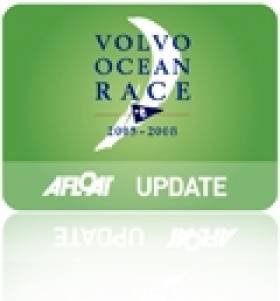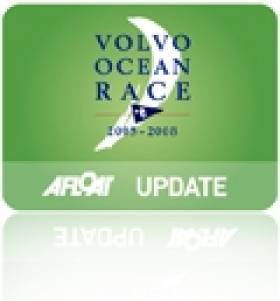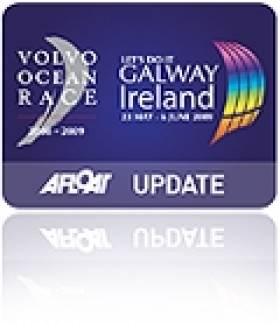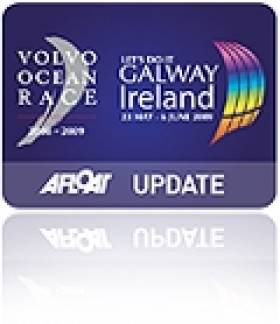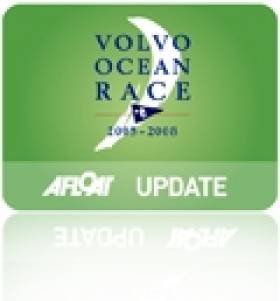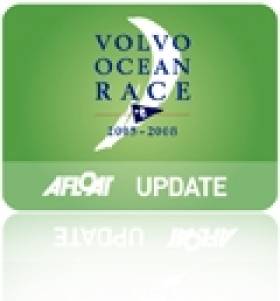Displaying items by tag: Abu Dhabi
#vor – Abu Dhabi Ocean Racing (Ian Walker/GBR) buried the miserable memories of the Volvo Ocean Race three years ago to win an epic Southern Ocean/south Atlantic crossing in Leg 5 and claim their second stage victory in the Volvo Ocean Race 2014-15. Wexford's Justin Slattery is part of Walker's crew racing as bowman on the favourite in the five boat fleet.
In 2012, Walker's crew were forced to return to Auckland with hull damage and eventually retired from the leg to Itajaí, Brazil.
They must have feared more of the same when Cyclone Pam delayed the departure from New Zealand for three days, but despite taking the worst that the Southern Ocean and then the south Atlantic could throw at them, the Emirati team emerged triumphant after nearly 19 days of ultra-challenging, super-tight sailing.
Amazingly, skipper Ian Walker reported that they had reached Itajaí with the least amount of work for their shore crew to do of any leg so far in this edition.
To add the icing to their cake, Abu Dhabi Ocean Racing set the new best mark in the chase for IWC prize for the most nautical miles (nm) sailed in 24 hours with 551nm leading up to Cape Horn.
The stage victory leaves Walker's team seven points clear at the top of the standings with five of the nine legs now completed.
Leg 5 finishing times
1. Abu Dhabi Ocean Racing - 18 days 23 hours 30 minutes 10 seconds
2. MAFPRE - 19d 00h 02min 56s
3. Team Alvimedica - 19d 00h 24min 32s
4. Team Brunel - 19d 00h 25min 48s
Team SCA (Sam Davies/GBR) had more than their share of problems, damaging three sails and then suffering a port rudder breakage on Sunday. They are expected to finish the leg on Tuesday.
Laser Fleets Face Final Race Showdown in Abu Dhabi
#laser – It will be a final day shootout in the Laser and Laser Radial fleets at the 2014 ISAF Sailing World Cup Final in Abu Dhabi, United Arab Emirates.
There is minimal separation in both fleets ahead of Sunday's double points do or die Medal Races following a thrilling penultimate day of racing. With the Medal Race places decided the competitors will be fighting it out for ISAF Sailing World Cup Final glory as well as a share of the USD$200,000 prize money.
Abu Dhabi treated the sailors to another glamorous day with a north westerly wind coming in around 10-13 knots which made for some exciting action.
Laser Radial
Just one point separates Belgium's Evi Van Acker and Denmark's Anne-Marie Rindom in the Laser Radial heading into the final day.
The Belgian, a London 2012 Olympic bronze medallist, and Danish racers traded blows on the penultimate day taking a win and a second apiece with minimal separation on the race track. Rindom came out flying in the opening race and took the lead from the start and she never looked back, sealing the deal by over 30 seconds over Van Acker.
Van Acker was dominant in the second race of the day, demonstrating exceptional downwind speed throughout to pull away from the pack.
As it stands Van Acker holds the lead on 11 points with Rindom on 12. Tuula Tenkanen (FIN) and Alison Young (GBR) are in the hunt behind the leading pair on 22 points but will likely fight their own battle on the final day.
"Wow, what a really nice day," beamed Van Acker after racing. "I really wasn't expecting this when coming to Abu Dhabi so yea, wow. It was a really nice day, really fun sailing with really big waves, nice breeze and how it should be every day.
"For me it was a good day. I was second in the first race but it didn't go so well. I was lucky to be really fast on the downwind so that made me some gains. In the second race I was good from the beginning and got the lead and kept on extending it. I am really happy."
Rindom was quick to echo her rivals thoughts on the days racing, "I like the weather, it's so much better than Denmark at this time of year," smiled Rindom, "I actually thought there was going to be no wind here but the conditions are so good.
"It was a brilliant day, I love the conditions and we had two good races which were done really fast by the Race Committee and the wind was perfect."
The level of competition in the Laser Radial fleet has been exceptional. World Champions in their numbers have battled it out over three days and now it all comes down to Sunday's Medal Race.
With double points on offer the game is wide open and Van Acker knows it's going to be tough, "I think I will just sail my own race. It's one point so you can't really do a lot. It's also quite close behind us so it's not like we have a 20 point lead over the rest. It will be really tricky and on the inside course [just off the Corniche] it will be really hard but I'm happy with my day and hoping to continue that tomorrow."
Rindom also remains wary, playing down her chances, "I don't know how I'll go into tomorrow yet, I have to go home and figure out what the points are. I can imagine there are some girls behind going for the win so we will just have to see."
Laser
World #1 Tom Burton and Matt Wearn are flying the Australian flag high in the Laser fleet at the ISAF Sailing World Cup Final in Abu Dhabi, UAE, occupying the top two spots in the ultra-competitive fleet.
Burton has been the standout performer of the week, recording three victories from six races. He leads on 11 points but his young compatriot, training partner, room-mate and rival Wearn piled on the pressure with an outstanding day on the water to pull within nine points.
Burton secured the opening race victory over Wearn by the narrowest of margins. Although Burton's lead seemed comfortable at the midway point of the race Wearn pushed hard to reduce the margin to two seconds at the final mark. Burton managed to hold on, narrowly, to take a slender victory.
Wearn ramped things up in the final race ahead of Sunday's deciding Medal Race and picked up an emphatic race win, finishing 60 seconds ahead of Jesper Stalheim (SWE). The result pulled the young Australian within reach of Burton and he was a happy sailor at the close of play, "I finally found some form," smiled Wearn. "I definitely needed it to get into that area to try and push for the top three. It's a bit of a shock to be up in second to be honest as the racing has just been so close in the Laser.
"With just 20 boats and one dropped score after six races anything can happen. But that's the way it is."
Burton and Wearn are sharing a room in Abu Dhabi and it will be a case of 'what goes on, on the race track, stays on the race track' on the final day. "I'm sure we'll have a good time tonight," joked Burton. "There will be a bit of banter and stuff like that but it's good to see an Australian one two."
"Matt and I train together a lot. I competed against [Tom] Slingsby in the regatta before he won the Olympic gold and I know how good a feeling it was for me to be just behind him. We train together so this will make for some good memories when we train this Australian summer."
Medal racing in a highlight competitive fleet is nothing new to Burton who has made the cut in all events he's competed at throughout 2014, picking up an abundance of medals along the way. For Wearn he has not faced off against all of the best Laser sailors in the world but goes in with no fear, "Tom's got a bit more experience than me in Medal Race situations but I think I'll go out there and just go for it. If I can win the race then anything can happen.
"It would be pretty big to finish on the podium. I had a bad regatta at the worlds so to get the confidence back up and get back into the groove of the Laser class would be really good."
An Australian one two is certainly on the cards but Tonci Stipanovic (CRO), Francesco Marrai (ITA) and Jean Baptiste Bernaz (FRA) are all within touching distance. Nonetheless the ever confident Burton remains upbeat, "Depending on what the conditions are we will see what we can do. I'll see what the conditions are like tomorrow. I think that maybe there will be some more breeze and inside here [just off of the Corniche] it should be interesting."
Racing is scheduled to commence at 10:00 local time on Sunday 30 November.
Slattery & Abu Dhabi Win Volvo Ocean Race Inshore Race off Cape Town
#vor – The Volvo Ocean Race marathon front-runners sure can sprint as well. Ian Walker's offshore leaders – with Ireland's Justin Slattery onboard – proved to the rest of the seven-strong fleet that they are currently masters closer to land too, winning the Cape Town In-Port race on Saturday after yet another thrilling finish.
Abu Dhabi Ocean Racing already lead the hunt for the Volvo trophy after claiming victory in Leg 1 last week and now they are looking to be serious contenders for the in-shore series silverware.
The fleet was split from the start in challenging conditions in Table Bay, under the famous Table Mountain, with winds veering dramatically between 12 and 20 knots and rain clouds threatening throughout.
Ian opted for a port line early in the sprint for the first mark and it paid immediate dividends as they and Team SCA raced clear.
The team from the Emirates have already shown they can make the right decisions under the toughest of pressure.
They edged out Dongfeng Race Team by just 12 minutes in a thrilling Leg 1 climax last week, after 25 days of sailing from Alicante to Cape Town.
After some 20 minutes of racing on Saturday, they already looked like they had the points in the bag, especially after one of the rivals for the in-port series prize, Team Alvimedica, suffered a tear in their jib.
Charlie Enright's team had triumphed in the opening in-port race in Alicante back on October 4 but this victory puts Abu Dhabi now back on top of the points table with three (lowest is best).
The battle for second place soon grabbed the attention of most with Team SCA and Team Brunel in a rare old shootout after the Dutch found a burst of pressure midway round.
Brunel's skipper Bouwe Bekking told a press conference on Friday that the in-port series was not a big priority for him.
Ha! Yeah right. He and his crew were plainly giving it 110 percent as they scrambled with Team SCA for the second rung of the poldium.
But these women are very, very determined and as their skipper Sam Davies explained on Friday, strong winds certainly don't scare them after they did most of their pre-race training in similar conditions in Lanzarote.
A problem with a gennaker failing to unfurl cleanly finally scuppered their efforts to keep Bouwe and co at bay and Brunel made one final effort to catch Abu Dhabi up front.
Once again, Ian was ready for the challenge and by the finish line had a winning margin of a couple of hundred metres from Brunel with the girls in third.
Dongfeng raced home ahead of Team Vestas Wind and Team Alvimedica with MAPFRE, last coming into Cape Town in Leg 1, again bringing up the rear.
The Spanish crew, unlike most of us, will be glad to farewell Table Mountain.
For the Azzam crew, they would be glad to do the rest of their sailing in this sailing-crazy city.
"Cape Town can be like that when the wind comes round Table Mountain. We had really good crew work today, I was out of breath just watching them," said Ian.
"We just tried to do the right thing and our navigator, Simon Fisher, did a good job controlling the race. Two down, plenty more to go."
Check out the scoreboard here.
VOR Roundup: Abu Dhabi Returns, Puma Quits Sailing
#VOR - Abu Dhabi will return to the Volvo Ocean Race in 2014-15 both with a sailing team and a stopover in the UAE capital, it was announced earlier this week.
Once again skippered by Ian Walker, the team is the third confirmed entrant in the 12th edition of the round-the-world yacht race, after the all-woman Team SCA and a team representing the Brazilian state of Pernambuco.
The Abu Dhabi team joined the last edition of the race under the auspices of former commercial director David Hassett, who was previously instrumental in bringing the race to Galway for the first time in 2009, and was one of the team behind Ireland's underdog entry the Green Dragon, which surprised the yachting world by clinching three podium finishes.
Meanwhile, the stopover will be the end point of Leg 2 from Recife in Brazil, making for "one of the longest and most challenging in the 40-year history of this race" according to Volvo Ocean Race CEO Knut Frostad.
"Heading into the Southern Ocean is never easy and this route will test the sailors to the limit," he added. "The finish line in Abu Dhabi will be one of the most eagerly awaited in the race.”
The news comes two weeks after Newport in Rhode Island was announced at the sixth host port of the race - and an understanding that no Irish ports will feature in the final route, according to The Irish Times.
Elsewhere, the VOR website visits the Persico factory in Italy in where the hulls are being completed for the new design VOR 65 in its latest video update - and also takes a look at the construction of the rigs for the new boat at Southern Spars in New Zealand.
In other news, it's emerged that Puma is pulling out of the sailing market, cutting its support for the Oracle team in the America's Cup and permanently dry-docking its Volvo Ocean Race team.
Reuters reports that the decision was made in the face of dwindling profits at the German sportswear brand.
Puma came third in the last edition of the VOR, which has its successful climax in Galway last summer.
Exotic Sailing Dhows Join Volvo Ocean Race in Galway
#VOLVO OCEAN RACE - In final dash of colour and excitement to mark the end of Volvo Ocean Race finale week, two high performance sailing dhows – the distinctive Arabian sailing boats often compared to the famous Galway hookers – will bring an exotic flavour to the City of the Tribes.
The dhows, which are being presented to Galway City by the United Arab Emirates, will race on Galway Bay tomorrow Saturday 7 and on Sunday 8 July, crewed by 10 Emirati sailors who have flown in for the occasion.
The boats were earlier air-freighted from the UAE to Shannon Airport and taken by road to Galway where they were assembled and prepared for their weekend racing display.
The gift of the dhows to Galway is part of a newly inaugurated maritime heritage cultural exchange programme between the Galway Hooker Association and the Emirates Heritage Club in Abu Dhabi that has already seen the famous Nora Bheag and her crew set sail in the Persian Gulf city, as previously reported on Afloat.ie.
Padraic De Bhaldraithe, joint co-ordinator of the unusual exchange programme, said: “We were really delighted to take Nora Bheag and her crew to sail in Abu Dhabi and we were amazed by the amount of interest they attracted.
It was to be the first step in a partnership which has now seen two dhows make their way to Galway. Abu Dhabi and Galway have much in common when it comes to their maritime traditions.”
Enda O’Coineen - chairman of Let’s Do It Global, the organising committee of the nine-day festival built around the Volvo Ocean Race finale - says the arrival of the dhows is already creating huge excitement in the city, and the weekend racing should be spectacular.
“Dhows are built on lines similar to the traditional Galway hooker and are capable of very high speeds when raced in the hands of experienced sailors," he explained. “They are often fixed in the western imagination as a romantic Arabian seacraft of the past but they are still used for the transport of goods today and are also undergoing a dramatic revival among sailors in the UAE who don't want to lose their traditional past.”
Clifden-based Dr Peter Vine, who has been closely involved in the Irish-Abu Dhabi partnership, says the 'Dhows for Galway' project has huge potential and could add impetus to the move to revived and foster traditional boat-building skills that were on the verge of dying out.
The exchange programme has been co-ordinated with support of Let’s Do It Global; Emirates Heritage Club; Abu Dhabi Sailing and Yacht Club; Galway Hooker Association, Cóilín Hernon and family; Royal Galway Yacht Club; long-time Irish resident of Abu Dhabi, Noeleen Saeed; Etihad Airways; AlHosn University; Peter Vine; and Padraic De Bhaldraihe.
Volvo Ocean Race Brings Galway and Abu Dhabi Closer Together
#VOLVO OCEAN RACE - A golden dhow presented to the city of Galway by the Abu Dhabi Sailing and Yacht Club marks the new connection between these host ports of the 2011-2012 Volvo Ocean Race.
The Galway Advertiser reports on the Galway-Abu Dhabi Maritime Cultural Exchange initiative, which has already seen a Galway hooker race against traditional Arabian dhows in the Persian Gulf.
Both cities have been "engaged for many years with restoration of traditional boats and revival of sailing skills," says the paper.
Their co-operation is being seen as a model for using sailing as a catalyst to bring different cultures together. And the gesture will be reciprocated when Galway hosts the race finale this July, as six dhows and 60 Emirati crew will be hosted in the city for an exhibition race against a fleet of Galway hookers.
Meanwhile, Galway's Tidy Towns committee is determined to make the city look its best in time for the race's arrival.
The City of the Tribes scored well in 2011 after a long absence, but is looking to take things a step further for 2012.
Interested volunteers can contact the Galway Volunteer Centre, Mill Street at 091 539 930.
Volvo Ocean Race in Galway Will See Irish Food in Focus
#VOLVO OCEAN RACE - Top chef Maurice Keller was in Abu Dhabi last week to fly the flag for Irish food at the third stopover of the Volvo Ocean Race, Waterford Today reports.
Keller spent a few days away from Waterford's Arlington Lodge to join members of Good Food Ireland, Tourism Ireland and Irish embassy staff for a special 'Ireland Day' at the VOR Village.
The initiative was designed to promote Ireland as a prime tourist destination ahead of this summer's Volvo Ocean Race visit to Galway.
And food will play a major role in efforts to attract visitors to the finish line in Galway this July, according to the Limerick Post.
Foodies from across the mid-west will converge at a 'Foodie Forum' at the Galway-Mayo Institute of Technology on 2 Feburary, where plans to showcase Irish food in the city will be top of the agenda.
“At the launch of the countdown to the Volvo Ocean Race, the Let's Do It Galway team announced the four main pillars of the race next summer – marine, green, innovation and food," said Cáit Noone, head of the Hotel School at GMIT.
"The food pillar will provide Ireland with a global showcase opportunity to share with the world our food experiences and the outstanding locally sourced produce we have to offer.”
Showcase for Galway at VOR 'Irish Day' in Adu Dhabi
#VOLVO OCEAN RACE - Galway was showcased on Friday 6 January as part of special a 'Irish Day' celebration in Abu Dhabi, where the Volvo Ocean Race fleet is getting ready to embark on its next leg.
Galway Bay FM reports that the City of the Tribes was highlighted as a top international tourism destination - with the 'VOR Village' at Nimmo's Pier being a focus of discussions, according to Galway Mayor Hildegarde Naughton.
Earlier in the week saw the first sailing in Arab waters of the near-century-old Galway hooker Nora Bheag, which is in Abu Dhabi as part of a cultural exchange between these host ports of the 2011/2012 Volvo Ocean Race.
The race is set to finish in Galway on Tuesday 3 July 2012, attracting the world's media and thousands of visitors to Ireland's fifth largest city for the final prize-giving.
First Sail for Galway Hooker in Arab Waters
#GALWAY HOOKER – The near century old Galway Hooker boat Nora Bheag, was finally taken out of her container in perfect condition in Abu Dhabi yesterday with plenty of water and sponges deployed to to keep her wooden hull moist in the hot climate.
She arrived safely in the Arab port after an historic voyage that set out from Galway over eight weeks ago.


First sail for Little Nora in Abu Dhabi
Little Nora, which also means "Little Light" in Arabic, is in Abu Dhabi as part of a cultural exchange programme between Abu Dhabi and Galway, both hosts of the Volvo Ocean Race 2011- 2012. This is a joint initiative involving the Irish Ambassador to the United Arab Emirates, Emirates Heritage Club, Abu Dhabi Tourism Authority and Tourism Ireland.
Her owner, Cóilín Hernon along with his family, crew Mike and Sue Fahy and Galway Hooker Association founder Padraic de Bhaldraithe carefully unloaded Nora Bheag from the container with the assistance of the Emirates Heritage Club and Abu Dhabi Tourism Authority.
She was launched from the slipway in the Volvo Ocean Race team base area into the Arabian Gulf. Once successfully rigged she made her way under sail towards the Emirates Heritage Club, her new home club while in Abu Dhabi. This short trip was the first time a Galway Hooker has sailed these waters.
She'll also be moored in the Volvo Ocean Race village where preparations are under way for the Irish Day festivities on the 6th of January in the Abu Dhabi race village. Guests will be welcomed out on board to experience sailing on her.
The return exchange will see six Abu Dhabi Dhow's travel to Galway to race against a fleet of Galway Hookers. The exhibition challenge will take place in Galway Bay during the finale celebrations of the Volvo Ocean Race and Global Village 2012 in July this year.
With both cities hosting a stopover for the grueling 39,000 mile round the world "Everest of Sailing' in 2012, the initiative celebrates common ties between the two. It is hoped that this type of promotion will generate a significant number of new tourist visitors and attract businesses from the Middle East to Ireland.
Enda O'Coineen, Chairman of Let's Do It Global – the not for profit foundation responsible for bringing the Volvo Ocean Race back to Ireland said he was delighted at how the cultural exchange was unfolding, "The working Arab Dhow is very symbolic of Arab culture and their history through trade is highly respected. Mixed in with the very modern aspects of Abu Dhabi the Dhow is sacred as a link with the past", said Enda, "Likewise the Galway Hooker was the workboat of the West of Ireland and has similar attributes. We are really looking forward to hosting the Dhows in Galway in July."
VOR Second Leg Cut Short Over Piracy Concerns
#VOLVO OCEAN RACE - The second leg of the Volvo Ocean Race from Cape Town to Dubai has been cut short by organisers as a result of the growing threat of piracy in the Indian Ocean, The Irish Times reports.
The six yachts competing will be protected by armed guards as they are shipped on a secret route to the United Arab Emirates due to piracy concerns.
The boats will be transported by ship from an undisclosed location to Sharjah in the Arabian Gulf, from where they will sprint to the finish line in Abu Dhabi.
All six teams are currently in Cape Town, with Team Sanya, PUMA and Abu Dhabi Ocean Racing hoping to get back in the race after retiring in the first leg.
As previously reported on Afloat.ie, NATO recently foiled a pirate attack on a Spanish fishing vessel between the Seychelles and the Somali coast.
The Irish Times has more on the story HERE.




























